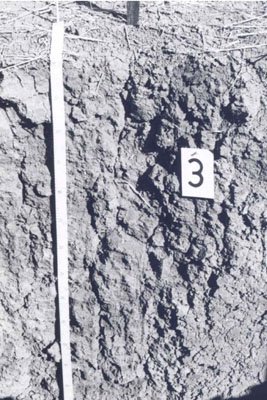IS12
Location: Longerenong.
Australian Soil Classification: Endocalcareous-Endohypersodic, Epipedal, Grey VERTOSOL
Northcote Factual Key: Ug5.29
Great Soil Group: grey clay
Soil Type: Murtoa Clay
General Landscape Description: Anastomotic plain.
Geology: Quaternary Shepparton Formation: fluvial silt, sand and minor gravel.
Soil Profile Morphology:
Surface Soil
| A1 | 0-5 cm | Dark grey (10YR4/1); light clay; subplastic; cracking and self-mulching surface condition; moderate coarse subangular blocky structure; very strong consistence dry; slightly sticky consistence wet; pH 7.2; sharp and wavy boundary to: |  IS12 Profile. |
| Subsoil | |||
| B21 | 5-25 cm | Grey (5Y5/1); light clay; subplastic; moderate coarse prismatic structure; strong consistence dry; moderately sticky consistence wet; pH 8.9. | |
| B22 | 25-60 cm | Grey (5Y5/1); heavy clay; subplastic; moderate coarse prismatic structure; strong consistence dry; moderately sticky consistence wet; very few (<2%) hard and soft carbonate segregations; pH 9.2; sharp and wavy boundary to: | |
| B23 | 60-110 cm | Grey (5Y5/1); heavy clay; plastic; coarse lenticular structure (slickensides); strong consistence dry; moderately sticky consistence wet; very few (<2%) hard carbonate segregations; pH 9.3; gradual boundary to: | |
| B31 | 110-150 cm | Greyish brown (10Y5/2); heavy clay; plastic; coarse lenticular structure (slickensides); strong consistence dry; slightly sticky consistence wet; very few (<2%) hard carbonate segregations; pH 9.3; gradual boundary to: | |
| B32 | 150-180 | Brown (10Y5/3); heavy clay; plastic; coarse lenticular structure (slickensides); strong consistence dry; slightly sticky consistence wet; pH 9.1; gradual boundary to: | |
| B33 | 180-215 | Greyish brown (10Y5/2); heavy clay; plastic; coarse lenticular structure (slickensides); strong consistence dry; slightly sticky consistence wet; pH 8.9. | |
Chemical and Physical Analysis:
Horizon | Sample Depth cm | pH H2O | EC dS/m | Sodium Chloride % | Exchangeable Calcium cmol-/kg | Exchangeable Magnesium cmol-/kg | Exchangeable Potassium cmol-/kg | Exchangeable Sodium cmol-/kg | Organic Carbon % | Total Nitrogen % | Exchangeable Acidity cmol-/kg | Field Capacity -30okPa | Permanent Wilting Point -1500okPa | Coarse Sand % | Fine Sand % | Silt % | Clay % |
A1 | 0–5 | 7.2 | 0.11 | 0.02 | 9.9 | 8.7 | 2.5 | 0.7 | 1.13 | 0.11 | 6.7 | 34.2 | 18.4 | 7 | 23 | 8 | 59 |
B21 | 5–25 | 8.9 | 0.14 | 0.02 | 16.6 | 14.2 | 2 | 3.1 | 0.32 | 0.05 | 3 | 42.3 | 25.7 | 3 | 7 | 6 | 83 |
B22 | 25–60 | 9.2 | 0.24 | 0.02 | 13.4 | 17.3 | 2.1 | 5.6 | 0.26 | 0.03 | 21.9 | 3 | 9 | 6 | 81 | ||
B23 | 60–110 | 9.3 | 0.41 | 0.05 | 9.7 | 17 | 1.9 | 8.7 | 0.22 | 0.02 | 26.7 | 4 | 11 | 8 | 76 | ||
B31 | 110–150 | 9.3 | 0.64 | 0.11 | 6.6 | 14.5 | 1.7 | 10.4 | 0.11 | 0.02 | 24.2 | 5 | 14 | 9 | 69 | ||
B32 | 150–180 | 9.1 | 0.62 | 0.12 | 25.2 | 4 | 15 | 10 | 70 | ||||||||
B33 | 180–215 | 8.9 | 0.67 | 0.11 | 24.8 | 4 | 15 | 10 | 69 |
Management Considerations:
- Cracking clay profile, very high clay percentage, decreasing below upper subsoil
- Neutral thin surface soil and alkaline below
- Friable self mulching surface, feels lighter than lab data suggests (subplastic), as does upper subsoil
- Calcium percentage decreasing with depth
- Yellow hue profile(5Y) and lighter coloured deep subsoil, poorer internal drainage
- Subsoil is strongly sodic and salinity increases at depth, particularly below 50cm
- Cracking may allow air and seasonal moisture to penetrate
- Very strong consistence when dry, implications for compaction and implement use
- Landform element, plain: poor site drainage


